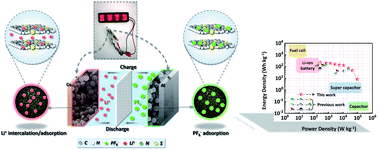Boosting chem-insertion and phys-adsorption in S/N co-doped porous carbon nanospheres for high-performance symmetric Li-ion capacitors†
Abstract
Li-ion capacitors (LICs) are seen as promising energy devices that combine the advantages of lithium-ion batteries (LIBs) and supercapacitors (SCs). However, it is challenging for LICs to achieve high energy densities at high power densities due to the mismatch between the kinetic properties of the LIB-type anode and the SC-type cathode. Herein, we constructed a symmetric LIC (SLIC) with both high power and energy densities by boosting the electrochemical insertion and capacitive adsorption in carbon-based electrodes. Density functional theory calculations combined with the experimental results proved that the excellent electrochemical performances are due to our well-prepared carbon that has a high content of heteroatom dopants (S and N), large surface area with porosity and enlarged interlayer space. These properties endow the carbon with high electrical conductivity, abundant active sites, reduced Li+ diffusion barrier, as well as rapid ion transport and large ion storage in both the anode and cathode. As a result, the assembled SLIC can deliver a high energy density of 222.9 W h kg−1 at 275 W kg−1. Even at an ultrahigh power density of 93.8 kW kg−1, with a discharging time of 0.32 s, the SLIC can still maintain an energy density of 8.3 W h kg−1, as well as an ultralong cycle life (0.0026% energy decay per cycle over 10 000 cycles at 5 kW kg−1).



 Please wait while we load your content...
Please wait while we load your content...